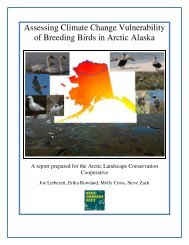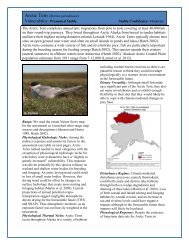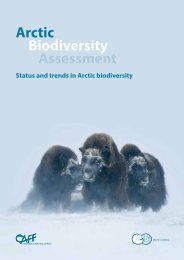Permafrost Terrain Stability and Thermokarst Monitoring: - Arctic LCC
Permafrost Terrain Stability and Thermokarst Monitoring: - Arctic LCC
Permafrost Terrain Stability and Thermokarst Monitoring: - Arctic LCC
Create successful ePaper yourself
Turn your PDF publications into a flip-book with our unique Google optimized e-Paper software.
26. Czudek, T., <strong>and</strong> Demek, J., 1970, <strong>Thermokarst</strong> in Siberia <strong>and</strong> its influence on the<br />
development of lowl<strong>and</strong> relief: Quaternary Research, v. 1, no. 1), p. 103–120.<br />
This paper presents an overview on the development of thermokarst l<strong>and</strong>forms <strong>and</strong> their role<br />
in lowering the elevation of the regional l<strong>and</strong> surface in the Siberian lowl<strong>and</strong>s. Two modes<br />
of thermokarst development are distinguished: (1) back-wearing <strong>and</strong> (2) down-wearing.<br />
Back-wearing refers to the lateral development of thermokarst features <strong>and</strong> results in the<br />
formation of gullies, thermocirques, <strong>and</strong> slump head walls. Down-wearing refers to<br />
formation of thermokarst through an increase in the active-layer thickness or the top-down<br />
thaw of permafrost that leads to development of “alas” terrain. Back-wearing features tend<br />
to be more local in nature <strong>and</strong> down-wearing features tend to be more regional in nature.<br />
The extent of the geomorphic changes for all thermokarst features depends on the tectonic<br />
regime of the region (stable, rising, or lowering), the ice content of the soil <strong>and</strong> the presence<br />
of epigenetic or syngenetic permafrost, <strong>and</strong> the rate of disequilbrium disturbance or the<br />
disturbance to the ground thermal regime. The paper has several diagrams showing the<br />
formation of various thermokarst features. This paper is mostly descriptive in nature <strong>and</strong><br />
does not contain information on the rates of thermokarst formation nor the regional<br />
distribution.<br />
27. Daanen, R.P., Grosse, G., Darrow, M.M., Hamilton, T.D., <strong>and</strong> Jones, B.M., 2012,<br />
Rapid movement of frozen debris-lobes—Implications for permafrost degradation <strong>and</strong><br />
slope instability in the south-central Brooks Range, Alaska. Natural Hazards <strong>and</strong><br />
Earth System Sciences, v. 12, p. 1521–1537.<br />
This paper describes reconnaissance-level investigations of unusual debris mass movement<br />
features (referred to as “frozen debris-lobes”) in the south-central Brooks Range of Alaska.<br />
A combination of ground-surveys, remote sensing, <strong>and</strong> field <strong>and</strong> laboratory measurements,<br />
<strong>and</strong> time-lapse observations were used to document the movement indicators that include<br />
toppling trees, slumps <strong>and</strong> scarps, detachment slides, striation marks on frozen sediment<br />
slabs, buried trees <strong>and</strong> other vegetation, mudflows, <strong>and</strong> large cracks in the lobe surface.<br />
Some of the frozen debris lobe features are greater than 100 m in width, 20 m in height, <strong>and</strong><br />
1,000 m in length. The features have responded to climate change by increasing in their<br />
downslope movement during the last several decades. Mean annual rates of movement were<br />
from 2 to 4 m/yr over decadal time periods. The features showed signs of creep, slumping,<br />
viscous flow, blockfall <strong>and</strong> leaching of fines in warm seasons; <strong>and</strong> creep <strong>and</strong> sliding of<br />
frozen sediment slabs in cold seasons. The potential hazard of one frozen debris lobe feature<br />
as it encroached on the Dalton Highway was highlighted.<br />
28. Dallimore, S.R., Wolfe, S.A., <strong>and</strong> Solomon, S.M., 1996, Influence of ground ice <strong>and</strong><br />
permafrost on coastal evolution, Richards Isl<strong>and</strong>, Beaufort Sea coast, NWT: Canadian<br />
Journal of Earth Sciences, v. 33, no. 5, p. 664–675.<br />
This paper provides information on the role of ground ice on coastal change for Richards<br />
Isl<strong>and</strong>, Canada. Excess ice content for the coastal segment was estimated at 20 percent <strong>and</strong>,<br />
when this was considered, the balance between headl<strong>and</strong> erosion <strong>and</strong> coastal deposition was<br />
in near equilibrium. The coastal part eroded by thermo-mechanical niche erosion <strong>and</strong> block<br />
collapse as well as permafrost slumping. Parts of the coast with higher ice content tended to<br />
erode faster than less ice-rich coastal area. Mean annual coastal erosion rates ranged from 1<br />
to 2 m/yr between 1947 <strong>and</strong> 1985.<br />
12








